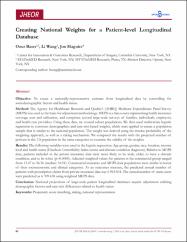Please use this identifier to cite or link to this item:
https://hdl.handle.net/20.500.11779/731Full metadata record
| DC Field | Value | Language |
|---|---|---|
| dc.contributor.author | Başer, Onur | - |
| dc.contributor.author | Li Wang | - |
| dc.contributor.author | Maguire J. | - |
| dc.date.accessioned | 2019-02-28T13:04:26Z | - |
| dc.date.accessioned | 2019-02-28T11:08:21Z | - |
| dc.date.available | 2019-02-28T13:04:26Z | - |
| dc.date.available | 2019-02-28T11:08:21Z | - |
| dc.date.issued | 2016 | - |
| dc.identifier.citation | Baser O, Wang L, Maguire J. (2016). Creating national weights for a patient-level longitudinal database. JHEOR. 4(1) s. 80-89. | en_US |
| dc.identifier.uri | https://hdl.handle.net/20.500.11779/731 | - |
| dc.description | Onur Başer (MEF Author) | en_US |
| dc.description | ##nofulltext## | en_US |
| dc.description.abstract | To create a nationally-representative estimate from longitudinal data by controlling for sociodemographic factors and health status. The Agency for Healthcare Research and Quality’s (AHRQ) Medicare Expenditures Panel Survey (MEPS) was used as the basis for adjustment methodology. MEPS is a data source representing health insurance coverage cost and utilization, and comprises several large-scale surveys of families, individuals, employers, and health care providers. Using these data, we created subset populations. We then used multivariate logistic regression to construct demographics and case-mix-based weights, which were applied to create a population sample that is similar to the national population. The weight was derived using the inverse probability of the weighting approach, as well as a raking mechanism. We compared the results with the projected number of persons in the US population in the same categories to examine the validity of the weights. The following variables were used in the logistic regression: Age group, gender, race, location, income level and health status (Charlson Comorbidity Index scores and chronic condition diagnosis). Relative to MEPS data, patients included in the private insurance data were more likely to be male, older, to have a chronic condition, and to be white (p=0.0000). Adjusted weighted values for patients in the commercial group ranged from 15.47 to 36.36 (median: 16.91). Commercial insurance and MEPS data populations were similar in terms of their socioeconomic and clinical categories. As an outcomes measure, the predicted annual number of patients with prescription claims from private insurance data was 6 963 034. The annual number of statin users were predicted as 6 709 438 using weighted MEPS data. National projections of large-scale patient longitudinal databases require adjustment utilizing demographic factors and case-mix differences related to health status. | en_US |
| dc.language.iso | en | en_US |
| dc.relation.ispartof | JHEOR | en_US |
| dc.rights | info:eu-repo/semantics/closedAccess | en_US |
| dc.subject | Raking | en_US |
| dc.subject | National Representation | en_US |
| dc.subject | Propensity Score Matching | en_US |
| dc.title | Creating National Weights for a Patient-Level Longitudinal Database | en_US |
| dc.type | Article | en_US |
| dc.relation.publicationcategory | Makale - Uluslararası Hakemli Dergi - Kurum Öğretim Elemanı | en_US |
| dc.identifier.endpage | 89 | en_US |
| dc.identifier.startpage | 80 | en_US |
| dc.identifier.issue | 1 | en_US |
| dc.identifier.volume | 4 | en_US |
| dc.department | İİSBF, Ekonomi Bölümü | en_US |
| dc.institutionauthor | Başer, Onur | - |
| item.grantfulltext | open | - |
| item.fulltext | With Fulltext | - |
| item.languageiso639-1 | en | - |
| item.openairetype | Article | - |
| item.openairecristype | http://purl.org/coar/resource_type/c_18cf | - |
| item.cerifentitytype | Publications | - |
| Appears in Collections: | Ekonomi Bölümü Koleksiyonu | |
Files in This Item:
| File | Description | Size | Format | |
|---|---|---|---|---|
| 10.36469_9828.pdf | Yayıncı Sürümü - Makale | 346.97 kB | Adobe PDF |  View/Open |
CORE Recommender
Page view(s)
36
checked on Nov 18, 2024
Download(s)
8
checked on Nov 18, 2024
Google ScholarTM
Check
Items in GCRIS Repository are protected by copyright, with all rights reserved, unless otherwise indicated.